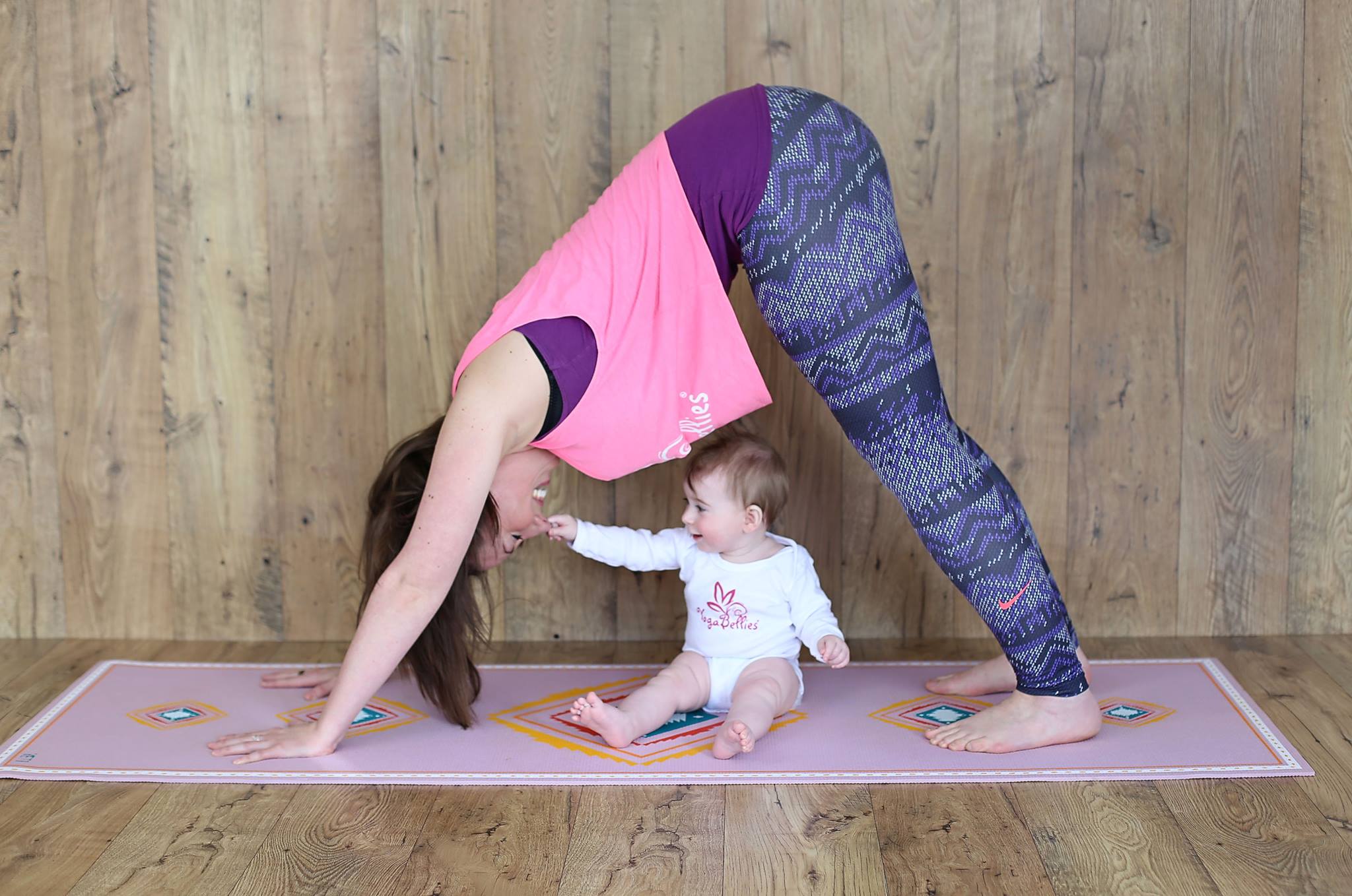Why Mum And Baby Yoga is Good For Everyone
 Contributed by
Cheryl MacDonald
October 17, 2015
Contributed by
Cheryl MacDonald
October 17, 2015

Mum and baby yoga is becoming increasingly popular, as post-partum women discover the benefits of being able to ‘work out,’ bond with their baby, and relax all in one session. Many women turn to yoga for the first time during pregnancy (YogaBellies Birth Outcome Survey 2012) being attracted by the calming and strengthening aspects of yoga.
What Are ‘Post-Natal’ And ‘Baby’ Yoga?
Post-natal and baby yoga are two distinct areas of yoga, but work best when practiced together. As new mothers very quickly realize, every activity from now on will involve baby, and what better time to embrace this than in the yoga class?
Post-natal, baby yoga, and mum and baby yoga classes are now widely available across the UK, although yoga with baby is no new thing, as baby yoga and massage have been practiced for thousands of years in India.
Yoga and Post-natal Depression
The social aspects of post-natal yoga are fantastic for mum. Not only is mum able to meet up with other mums and ‘get out of the house,’ it also helps increase their confidence and rebuild their pre-pregnancy body. Importantly, yoga has also been shown to alleviate and prevent the symptoms of post-natal depression (Read, S. et al. 2010).
A regular yoga practice can reduce the production of stress hormones, such as when mum is lacking sleep and being overwhelmed by motherhood (Ram, 2009). By practising yoga, the breath steadies and the brain’s automatic impulse to create stress hormones is massively reduced. The nervous and endocrine systems are balanced, reducing the body’s reaction to stress. The body produces less stress hormones, and mother becomes calm. (Streeter et al. 2010).
When Can Mothers Begin Post-Natal Yoga?
Mum should wait 6-8 weeks post-partum for a ‘normal’ birth or 10 weeks for a C-section. The most important thing is that mothers listen to their body and be guided by how they feel. Mum should not exercise the pelvic floor muscles until there is no pain.
Many mothers go directly into intense physical exercise regimens in order to regain their pre-pregnancy shape, but this is the worst thing mum can do. Mum’s focus should be on gently rebuilding the pelvic floor and lower abdominal muscles. These muscles must be exercised in unison. Many mothers neglect the rebuilding of the pelvic floor, and this results in weakened abdominal muscles which have not recovered and very often on-going lower back pain also. By strengthening the pelvic floor and lower abdominals, we help strengthen the lower back and integrity of the spinal cord.
So What Exactly Is ‘Baby’ Yoga?
‘Baby yoga’ refers to the practice of yoga asana for baby. Yoga masters based adult yoga postures on the movements that new babies make naturally (think about Happy Baby Pose: where the baby lies on their back and grabs their toes – something babies do a lot!).
Babies today are often constricted and spend a lot of time in buggies, cots and car seats. Babies can become stressed and stiff just like adults. The purpose of baby yoga is to strengthen baby’s body and encourage flexibility and teach the principals of relaxation at an early age. Sessions also alternate between stimulating baby’s brain development and helping baby to relax. Baby yoga also teaches baby to self soothe (Garabedian 2004). At the end of a mum and baby yoga session, mothers often find that baby is happily exhausted, relaxed, and fast asleep.
In a baby yoga session, the teacher will show mother how to manipulate baby’s body in a very gentle way. For example, a posture may be practiced with focus on alleviating colic or another focusing on strengthening baby’s arms so that they can hold themselves up for crawling.
What Does a Mum And Baby Yoga Session Involve?
There are many variations to the structure of a ‘post-natal’ or ‘baby yoga’ class. Mums need to understand the differences in these classes to make sure that they get the most from the sessions. A post-natal yoga class will focus on post-partum mother. Baby is usually left in the buggy or placed to one side.
A ‘baby yoga’ class focuses on yoga for baby, aiming to help baby grow strong and healthy, often an extension of a baby massage class. This is a not a post-partum yoga class and the focus in on child rather than mother.
The best post-partum yoga classes involve a mixture of yoga for mum AND baby. Ideally, the class should involve post-natal yoga postures helping to strengthen mother’s mind and body as well as incorporating baby into the yoga practice with asana to help their little bodies also. Mum and baby yoga classes also encourage mother and baby bonding and communication.
Yoga breathing techniques and relaxation are also taught in class which help mum relax with baby (yes, it is possible) and to embrace this new responsibility.
What Should I Look for In A Mum And Baby Yoga Teacher?
Ideally, those teaching post-natal yoga have completed a perinatal yoga qualification from a Registered Perinatal Yoga School (RPYS,) with specific training in the areas of post-natal yoga and/or baby yoga. Mothers should always make sure their teacher is qualified to work safely and sensitively with post birth mum and baby.











Sorry, the comment form is closed at this time.